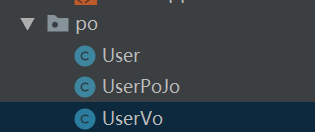Mybatis输入输出映射与动态Sql Mybatis中输入输出映射与动态Sql图文详解
风沙迷了眼 人气:0一、输入映射
我们通过配置parameterType的值来指定输入参数的类型,这些类型可以是简单数据类型、POJO、HashMap等数据类型
1、简单类型

2、POJO包装类型
①这是单表查询的时候传入的POJO包装类型,即可以直接传入实体类,但是当多表查询的时候,就需要自定义POJO类型

②我们使用自定义POJO类型来具体的了解一下
先设计 包装类型如下,其中UserPOJO是除了User本身之外的添加的其他跟User相关的属性的包装类,UserVo是用于视图层面的包装类型,同样也是作为Mapper配置文件的输入类型

其中User文件同上一篇Mybatis简单入门中的User,包括数据表部分也一样。这里给出UserPoJO和UserVo文件
package cn.mybatis.po;
public class UserPoJo extends User{
private User user;
public void setUser(User user) {
this.user = user;
}
public User getUser() {
return user;
}
}
UserPOJO
package cn.mybatis.po;
public class UserVo {
private UserPoJo userPoJo;
public UserPoJo getUserPoJo() {
return userPoJo;
}
public void setUserPoJo(UserPoJo userPoJo) {
this.userPoJo = userPoJo;
}
}
UserVo
然后我们配置UserMapper.xml文件

然后在UserMapper接口文件中添加
//测试包装类型的查询 public List<UserPoJo> findUserList(UserVo userVo) throws Exception;
使用Junit测试刚刚做的配置
@Test
public void testFindUserList() throws Exception {
SqlSession sqlSession = sqlSessionFactory.openSession();
UserMapper userMapper = sqlSession.getMapper(UserMapper.class);
UserPoJo userPoJo = new UserPoJo();
UserVo userVo = new UserVo();
userPoJo.setSex("男");
userPoJo.setUsername("u");
userVo.setUserPoJo(userPoJo);
List<UserPoJo> userPoJoList = userMapper.findUserList(userVo);
System.out.println(userPoJoList);
}
最后结果如下

二、输出映射
1、resultType
①在使用resultType进行映射的时候,只有查询出来的列名和包装类型中的属性名一致的时候,才会映射成功
②当使用简单类型作为输出映射的时候,我们需要保证Sql查询的结果只有一行一列,这样就可以使用简单类型
如下所示示例
SELECT COUNT(*) FROM t_user SELECT username FROM t_user WHERE id = 2
2、resultMap
查询出来的列名和包装类型的属性名不一致的时候,可以使用resultMap来进行相应的映射(具体在使用中来说就是:定义resultMap中和属性的映射关系,然后将输出结果设置为resultMap的类型)
下面我们使用一个例子来进行具体的测试
①首先编写mapper配置文件,其中需要加上resultMap的配置
<?xml version="1.0" encoding="UTF-8" ?>
<!DOCTYPE mapper
PUBLIC "-//mybatis.org//DTD Mapper 3.0//EN"
"http://mybatis.org/dtd/mybatis-3-mapper.dtd">
<mapper namespace="cn.mybatis.mapper.UserMapper">
<!--定义resultMap
type:resultMap最终映射的Java对象类型
id:对resultMap的标识
-->
<resultMap id="userResultMap" type="user">
<!--id:标识查询结果集中的唯一标识-->
<id column="_id" property="id"></id>
<!--result:标识查询结果集中其他列的标识-->
<result column="_username" property="username"></result>
<result column="_password" property="password"></result>
<result column="_sex" property="sex"></result>
<result column="_address" property="address"></result>
</resultMap>
<select id="findUserById_resultMap" parameterType="int" resultMap="userResultMap">
SELECT id _id, username _username, PASSWORD _password, address _address, sex _sex FROM t_user WHERE id = #{id}
</select>
</mapper>
②然后在Mapper接口中添加方法
//测试resultMap public User findUserById_resultMap(int id) throws Exception;
③ 测试方法
@Test
public void testFindUserById_resultMap() throws Exception {
SqlSession sqlSession = sqlSessionFactory.openSession();
UserMapper userMapper = sqlSession.getMapper(UserMapper.class);
User user = userMapper.findUserById_resultMap(2);
System.out.println(user);
}
④可以发现,使用resultMap的方式跟直接查询的结果是一致的

三、动态Sql
1、if判断
我们在上面使用包装类查询的用例的时候,考虑到可能出现userPoJo会是null的情况,以及其相应的属性也可能是null的情况,这样的话,如果我们直接在Sql中进行拼接而不做判断的话,可能会出现一些错误,所以我们使用if来进行动态的拼接。
<select id="findUserList" parameterType="cn.mybatis.po.UserVo" resultType="cn.mybatis.po.UserPoJo">
SELECT * FROM t_user
<where>
<if test="userPoJo != null">
<if test="userPoJo.sex != null and userPoJo.sex != ''">
AND sex = #{userPoJo.sex}
</if>
<if test="userPoJo.username != null and userPoJo.username != ''">
AND username LIKE '%${userPoJo.username}%'
</if>
</if>
</where>
</select>

2.Sql片段
上面的例子中,我们可以将if判断抽取出来作为一个Sql片段,这样做的好处是,可能再进行别的单表查询User信息的时候可以重复使用这些Sql。
<!--定义Sql片段-->
<sql id="query_user_info">
<if test="userPoJo != null">
<if test="userPoJo.sex != null and userPoJo.sex != ''">
AND sex = #{userPoJo.sex}
</if>
<if test="userPoJo.username != null and userPoJo.username != ''">
AND username LIKE '%${userPoJo.username}%'
</if>
</if>
</sql>
然后在别的Sql中将上面的Sql片段引入拼接即可
<select id="findUserList" parameterType="cn.mybatis.po.UserVo" resultType="cn.mybatis.po.UserPoJo"> SELECT * FROM t_user <where> <include refid="query_user_info"></include> </where> </select>
3.foreach
当我们需要一种同样的查询方式只是参数不同的时候:SELECT * FROM t_user WHERE 1=1 AND (id = 1 OR id =2 OR id = 3),可以使用foreach来记性sql拼接
<sql id="query_ids">
<if test="ids != null">
<!--
SELECT * FROM t_user WHERE 1=1 AND (id = 1 OR id =2 OR id = 3)
cilleation: 指定的是输入参数集合的属性名
item:每次遍历的名称
open:开始遍历时拼接串
close:结束遍历时候拼接的串
separator:遍历的两个对象中间需要拼接的串
-->
<foreach collection="ids" item="item_id" open="AND (" close=")" separator=" OR ">
id=#{item_id}
</foreach>
</if>
</sql>
然后将上面的Sql片段加入响应的statment中
<select id="findUserByIds" parameterType="userVo" resultType="userPoJo"> SELECT * FROM t_user <where> <include refid="query_ids"></include> </where> </select>
测试结果如下

总结
以上就是这篇文章的全部内容了,希望本文的内容对大家的学习或者工作具有一定的参考学习价值,如果有疑问大家可以留言交流,谢谢大家对的支持。
加载全部内容